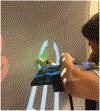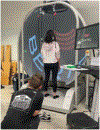THE ROLE OF PERIPHERAL VISION IN ENHANCING BALANCE AND POSTURAL STABILITY: INSIGHTS FROM CENTRAL VISION OBSTRUCTION
- PMID: 40599631
- PMCID: PMC12211638
THE ROLE OF PERIPHERAL VISION IN ENHANCING BALANCE AND POSTURAL STABILITY: INSIGHTS FROM CENTRAL VISION OBSTRUCTION
Abstract
This study examines the role of peripheral vision in maintaining postural stability, particularly when central vision is obstructed, using Sensory Organization Testing (SOT) with computer dynamic posturography. Ten participants (5 males, 5 females, aged 21-34 years) were tested under three conditions: full vision, full occlusion, and central vision obstruction allowing only peripheral vision access. Results revealed significantly better balance performance in the peripheral vision condition during somatosensory perturbations (Condition 4), with equilibrium scores higher than in the full vision condition (p = 0.02). Similarly, visual preference (VIS) scores, indicating reliance on visual input, were significantly elevated under peripheral vision conditions (p = 0.03). These findings highlight peripheral vision's critical role in improving postural sway and maintaining balance when central vision is impaired, as seen in conditions such as age-related macular degeneration (AMD). While central vision is vital for daily tasks requiring focused attention, peripheral vision provides crucial environmental cues for balance and stability. This research underscores the need for targeted interventions and balance training programs to mitigate fall risks in individuals with central vision loss. Future studies will explore these effects in populations with visual impairments to enhance clinical relevance and applicability of central vision on balance.
Keywords: Age-related Macular Degeneration (AMD); Peripheral vision; central vision; postural stability.
Figures





Similar articles
-
Reading aids for adults with low vision.Cochrane Database Syst Rev. 2018 Apr 17;4(4):CD003303. doi: 10.1002/14651858.CD003303.pub4. Cochrane Database Syst Rev. 2018. PMID: 29664159 Free PMC article.
-
Surgery for cataracts in people with age-related macular degeneration.Cochrane Database Syst Rev. 2017 Feb 16;2(2):CD006757. doi: 10.1002/14651858.CD006757.pub4. Cochrane Database Syst Rev. 2017. PMID: 28206671 Free PMC article.
-
Evaluation of Sensory and Motor Function in Spinal and Bulbar Muscular Atrophy Using Quiet Stance and Reactive Postural Control.Neurol Int. 2025 May 22;17(6):79. doi: 10.3390/neurolint17060079. Neurol Int. 2025. PMID: 40559318 Free PMC article.
-
Global burden of vision impairment due to age-related macular degeneration, 1990-2021, with forecasts to 2050: a systematic analysis for the Global Burden of Disease Study 2021.Lancet Glob Health. 2025 Jul;13(7):e1175-e1190. doi: 10.1016/S2214-109X(25)00143-3. Lancet Glob Health. 2025. PMID: 40580986 Free PMC article.
-
Prophylactic non-steroidal anti-inflammatory drugs for the prevention of macular oedema after cataract surgery.Cochrane Database Syst Rev. 2016 Nov 1;11(11):CD006683. doi: 10.1002/14651858.CD006683.pub3. Cochrane Database Syst Rev. 2016. PMID: 27801522 Free PMC article.
References
-
- Peterka RJ, “Sensory integration for human balance control,” in Balance, Gait, and Falls, (Handbook of Clinical Neurology, 2018, pp. 27–42. - PubMed
-
- Wood JM, Lacherez P, Black AA, Cole MH, Boon MY, and Kerr GK, “Risk of Falls, Injurious Falls, and Other Injuries Resulting from Visual Impairment among Older Adults with Age-Related Macular Degeneration,” Investigative Opthalmology & Visual Science, vol. 52, no. 8, 2011, doi: 10.1167/iovs.10-6644. - DOI - PubMed
Grants and funding
LinkOut - more resources
Full Text Sources
